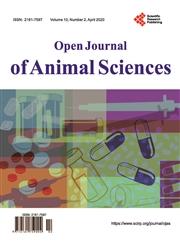Genetic Diversity and Population Structure of Three Strains of Indigenous Tswana Chickens and Commercial Broiler Using Single Nucleotide Polymormophic (SNP) Markers
引用次数: 0
Abstract
The Tswana chicken is native to Botswana and comprises strains such as the naked neck, normal, dwarf, frizzled, and rumples. The origins of the different strains of Tswana chicken remain unknown and it is not yet clear if the different strains represent distinct breeds within the large Tswana chicken population. Genetic characterization of different strains of Tswana chickens using SNP arrays can elucidate their genetic relationships and ascertain if the strains represent distinct breeds of Tswana chicken population. The aim of this study was therefore to investigate population structure and diversity and to estimate genetic distances/identity between the naked neck, normal and dwarf strains of Tswana chickens. A total of 96 chickens (normal strain (n = 39), naked neck strain (n = 32), dwarf strain (n = 13) and commercial broiler (n = 12)) were used in the study. SNP genotyping was carried out using the Illumina chicken iSelect SNP 60 Bead chip using the Infinium assay compatible with the Illumina HiScan SQ genotyping platform. The observed heterozygosity (Ho) values were 0.610 ± 0.012, 0.611 ± 0.014, 0.613 ± 0.0006 for normal, naked neck and dwarf strains of Tswana chickens respectively and averaged 0.611 ± 0.016 across the three strains of Tswana chickens compared to Ho of 0.347 ± 0.023 in commercial broiler chicken. The expected heterozygosity (He) values were 0.613 ± 0.00012, 0.614 ± 0.00013, 0.608 ± 0.00021 for normal, naked neck and dwarf strains of Tswana chickens respectively and averaged 0.612 ± 0.00015 across the three strains of Tswana chickens compared to He of 0.577 ± 0.00022 in commercial broiler chicken. Principal component analysis (PCA) was used to get an insight into the population structure of indigenous Tswana chickens. The first two principal components revealed a set of three clusters. The normal strain of Tswana chicken and commercial broiler clustered together in one group. The dwarf strain clustered separately in one group and the naked neck and normal strains clustered together in the last group. The separate clustering of the dwarf strain from the rest of Tswana chicken strains suggests significant genetic uniqueness of the dwarf strain and very close genetic similarities between the normal and naked neck strains. The clustering pattern was confirmed by less genetic differentiation and less genetic distances between the naked neck and normal strains of Tswana chicken than between the two strains and the dwarf strain of Tswana chicken.利用单核苷酸多态性(SNP)标记分析3个地方茨瓦纳鸡和商品肉鸡品系的遗传多样性和群体结构
茨瓦纳鸡原产于博茨瓦纳,包括裸颈鸡、普通鸡、侏儒鸡、卷曲鸡和皱褶鸡等品种。茨瓦纳鸡不同品系的起源仍然未知,目前尚不清楚这些不同品系是否代表了茨瓦纳鸡大种群中的不同品种。利用SNP阵列对不同茨瓦纳鸡品系进行遗传鉴定,可以阐明它们的遗传关系,并确定这些品系是否代表茨瓦纳鸡种群的不同品种。因此,本研究的目的是调查茨瓦纳鸡裸颈、正常和矮株的种群结构和多样性,并估计遗传距离/同一性。试验共选用96只鸡(正常品系39只,裸颈品系32只,矮化品系13只,商品肉鸡12只)。采用与Illumina HiScan SQ基因分型平台兼容的Infinium检测方法,使用Illumina鸡iSelect SNP 60 Bead芯片进行SNP基因分型。正常株、裸颈株和矮株茨瓦纳鸡的杂合度(Ho)分别为0.610±0.012、0.611±0.014和0.613±0.0006,平均为0.611±0.016,而商品肉鸡的Ho为0.347±0.023。正常株、裸颈株和矮株茨瓦纳鸡的期望杂合度(He)分别为0.613±0.00012、0.614±0.00013和0.608±0.00021,平均为0.612±0.00015,而商品肉鸡的He为0.577±0.00022。采用主成分分析(PCA)对土着茨瓦纳鸡种群结构进行了分析。前两个主要成分揭示了一组三个集群。正常菌株的茨瓦纳鸡和商品肉鸡聚集在一组。矮株单独聚集在一组,裸颈株和正常株聚集在最后一组。矮株与其他茨瓦纳鸡菌株的分离聚类表明矮株具有显著的遗传独特性,而正常株与裸颈株的遗传相似性非常接近。茨瓦纳鸡裸颈株与正常株之间的遗传分化较小,遗传距离也小于两株与茨瓦纳鸡矮株之间的遗传距离。
本文章由计算机程序翻译,如有差异,请以英文原文为准。
求助全文
约1分钟内获得全文
求助全文

 求助内容:
求助内容: 应助结果提醒方式:
应助结果提醒方式:


